
Willows, also called sallows and osiers, of the genus Salix, comprise around 350 species of typically deciduous trees and shrubs, found primarily on moist soils in cold and temperate regions.

Salix alba, the white willow, is a species of willow native to Europe and western and central Asia. The name derives from the white tone to the undersides of the leaves.

Salix purpurea, the purple willow, purpleosier willow, or purple osier, is a species of willow native to most of Europe and western Asia north to the British Isles, Poland, and the Baltic States.
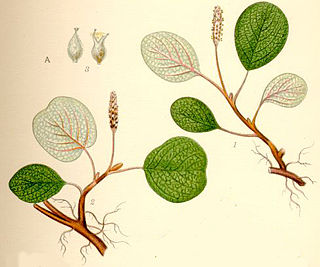
Salix reticulata, the net-leaved willow, or snow willow, is a dwarf willow, native to the colder parts of Europe, North America, and Northern Asia. It is found in the western United States, including the Sierra Nevada and Rocky Mountains. In Europe it extends south through the Carpathian Mountains and Alps to the Pyrenees and the mountains of Bulgaria and North Macedonia. It is common in Canada, Greenland and Finland, and present but rare in Scotland.

Salix integra is a species of willow native to north-eastern China, Japan, Korea and the far south-eastern Russia.

Salix koriyanagi is a species of willow native to the Korean Peninsula, and introduced to Japan. It can reach a height of 4 m (13 ft).

Salix udensis is a species of willow native to northeastern Asia, in eastern Siberia, northeastern China, and northern Japan.

Symphyotrichum ericoides, known as white heath aster, frost aster, or heath aster, is a species of flowering plant in the family Asteraceae native to much of central and eastern North America. It has been introduced to parts of Europe and western Asia.

Salix acutifolia, also known as Siberian violet-willow, long-leaved violet willow or sharp-leaf willow, is a species of flowering plant in the family Salicaceae, native to Russia and eastern Asia. It is a spreading, deciduous shrub or tree, growing to 10 m (33 ft) tall by 12 m (39 ft) wide. The young shoots are deep purple with a white bloom. The leaves are narrow, up to 10 cm (4 in) long. The catkins are produced in early spring, before the leaves. Older bark has a fine, netted pattern.
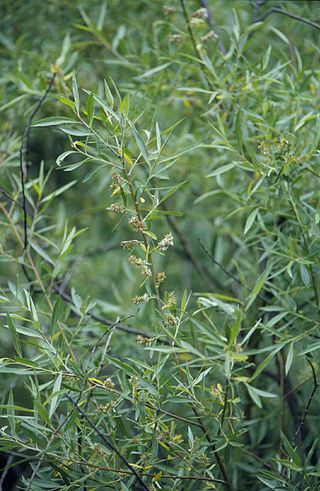
Salix geyeriana is a species of willow known by the common names Geyer's willow, Geyer willow and silver willow. The type specimen was collected by the botanist Karl Andreas Geyer, for whom it was named. Its conspicuous, yellow flowers begin to bloom as early as March, to as late as the end of June.

Salix eleagnos the bitter willow, olive willow, hoary willow, rosemary willow, or elaeagnus willow, is a species of flowering plant in the family Salicaceae, native to central and southern Europe and south west Asia. Growing to 3 m (10 ft) tall by 5 m (16 ft) broad, it is an erect bushy deciduous shrub with narrow grey-green leaves up to 20 cm (8 in) long, which turn yellow in autumn (fall). The green catkins, 3–6 cm (1–2 in) long, appear with the leaves in spring, male catkins having yellow anthers.

Salix alpina, the Alpine willow, is a species of flowering plant in the family Salicaceae, native to the Eastern Alps and the Carpatians, with one station in the Dinaric Alps. A creeping, mat-forming deciduous shrub, it is available in commerce. Its growth habit varies according to local conditions.
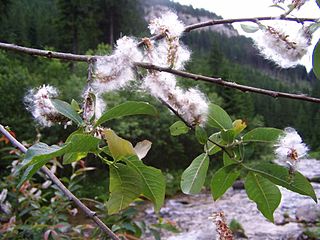
Salix silesiaca, the Silesian willow, is a species of flowering plant in the family Salicaceae. It is native to the Sudeten and Carpathian Mountains, and the mountains of the Balkan Peninsula. A shrub reaching 6 ft (2 m), it is considered to be a member of the informal sallow group.
Salix fruticulosa is a species of flowering plant in the willow family Salicaceae, native to Nepal, the eastern Himalayas, and Tibet. It is common in sub-alpine silver fir–birch forests from 2,800 to 3,800 m. Although there may some confusion about which species of dwarf willow is intended, Salix fruticulosa is listed by the Royal Horticultural Society as available from commercial suppliers.
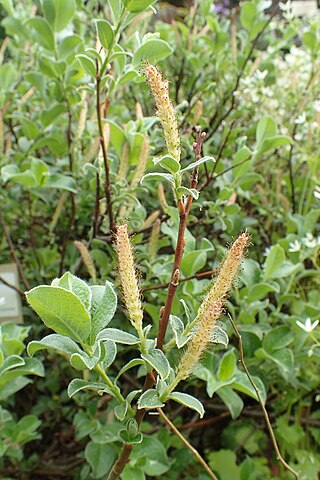
Salix pyrenaica, the Pyrenean willow, is a species of flowering plant in the family Salicaceae, native to the Pyrenees and Cantabrian Mountains. A shrub or subshrub with procumbent main stems, and ascending branches usually reaching 1.5 ft (0.5 m), it is occasionally available in commerce.

Salix uva-ursi, the bearberry willow, is a species of flowering plant in the family Salicaceae, native to subarctic and subalpine parts of northeastern North America and Greenland. A prostrate shrub, the extreme southern edge of its range is high in the mountains of northern New England.
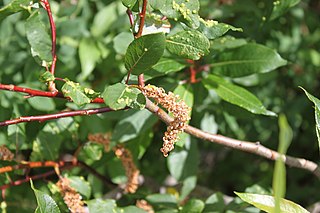
Salix pyrifolia, the balsam willow, is a species of flowering plant in the family Salicaceae, native to Canada, and the north-central to northeastern United States. A shrub, its leaves emit a balsam-like fragrance. It is available from commercial suppliers.
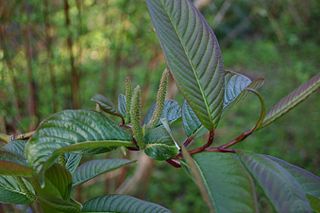
Salix moupinensis, the Moupin willow, is a species of flowering plant in the family Salicaceae, native to western Sichuan and northern Yunnan, China. It resembles Salix fargesii and is available from commercial suppliers.
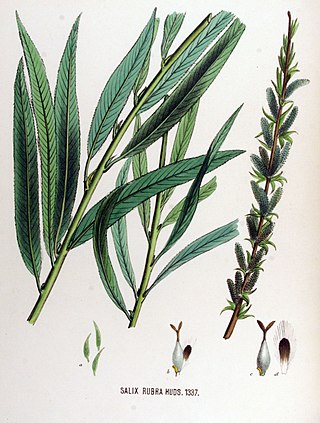
Salix × rubra, the green-leaved willow or red osier, is a naturally occurring hybrid species of flowering plant in the family Salicaceae. It is the result of crosses between Salix purpurea and Salix viminalis. It is native to a large part of Europe, found where the parent species' ranges overlap. The straight, flexible stems are prized by basketmakers. There are a number of cultivars, with the fastigiate 'Eugenei' being the best known.
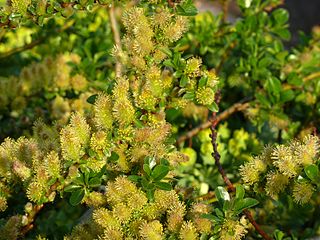
Salix apoda, the Caucasian willow, is a species of flowering plant in the family Salicaceae, native to the Caucasus and northern Turkey. A prostrate shrub, it is occasionally cultivated as an ornamental ground cover in rock gardens, particularly the males, since they produce large, silvery catkins that then erupt in yellow stamens.




















